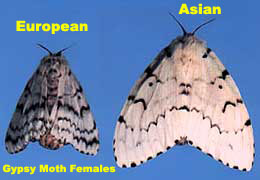|
Seems
like we just get used to one problem when another one appears
on the horizon. The European
gypsy moth has been defoliating
trees across the
Northeast United States for several decades. We are
just beginning to get a handle on this pest and now, an Asian
gypsy moth has been introduced and it poses even greater
challenges.
The Asian gypsy moth was
first found in North Carolina in 1998 on a ship carrying cargo
from Germany. Three types of moth were eventually found on the
ship including European gypsy moth, Asian gypsy moth and
hybrids of the two. Other outbreaks have been found in the
Pacific
Northwest too.
 Female
European gypsy moths do not fly. They basically stay at the
place where the caterpillar stopped and pupated. This helps
minimize their spread. Female
European gypsy moths do not fly. They basically stay at the
place where the caterpillar stopped and pupated. This helps
minimize their spread.
Asian gypsy moth females are strong fliers.
They may fly as far as 25 miles from where they lived as a
caterpillar. This could cause rapid movement across the
country. This new pest also eats a wider variety of hardwood
and conifer species than the European gypsy moth.
So far, the original outbreaks of the Asian
gypsy moth have been eradicated before they could move very
far. The USDA has stepped up its efforts at excluding further
introductions by close inspection of any shipping from
infested areas of
Europe or Russia. Hope they do a good job!
|



